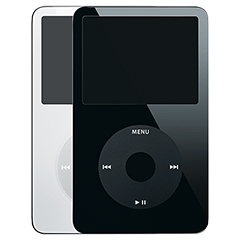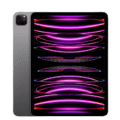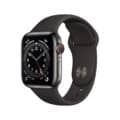- All Apple Devices
- iPod
- Apple iPod Classic 5th Generation
Apple iPod Classic 5th Generation



iPod Classic 5th Generation

Product Brand: Apple
4
Pros
- Large storage capacity (up to 80GB)
- Supports various audio and video formats
- Long battery life (up to 20 hours of audio playback)
- Easy to navigate through menus
- Durable and long-lasting design
- Click wheel for easy control
Cons
- No wireless connectivity (e.g. Wi-Fi, Bluetooth)
- No touchscreen or color display
- Bulky and heavy compared to newer devices
- No support for streaming services or apps
- Limited video playback options (no support for HD or widescreen)
- No built-in camera
Apple iPod Classic 5th Generation Review and Features
The fifth-generation iPod was introduced on October 12, 2005, shortly after the introduction of the iPod Nano. The fifth-generation iPod featured a 2.5″ 320×240 QVGA screen and a smaller Click Wheel. It was the first iPod to be able to play videos.
The fifth-generation iPod, sometimes colloquially known as the iPod Video, is the first iPod to be available in an alternative colour scheme in a non-special-edition form, as a black option was added alongside “Signature iPod White” and marked the second full redesign of the iPod’s aesthetic with its re-arranged proportions, its return to a fully flat front plate, and its more rounded rear casing.
The 4-pin remote port was also removed, causing backwards compatibility issues with certain accessories. A 30 GB model was offered for US$299, and a 60 GB model was offered for US$399. The fifth-generation iPod was also offered in the U2 special edition for US$349 with 30 GB. The fifth-generation iPod was the last model to have a plastic face.
The fifth-generation iPod was updated on September 12, 2006; this model is officially known as “iPod (Late 2006)” and is unofficially referred to as “5th generation enhanced” and “5.5th generation”. This update included a brighter screen, longer video playback time, improved video decoding hardware, newly designed earphones and a search feature.
An iTunes installation CD was no longer bundled, requiring users to download iTunes from Apple’s website. The 60GB model was replaced with an 80 GB model, and prices were cut by US$50 for both the 30 GB (US$249) and the 80 GB (US$349) models. Gapless playback and support for iPod games were enabled on all fifth-generation iPods through a firmware update released simultaneously.
The fifth-generation iPod plays video in MPEG-4 (up to 480p 2.5 Mbit/s) and H.264 (up to 240p, 768 kbit/s, baseline profile level 1.3 only) formats. The enhanced fifth-generation iPod, and firmware 1.2 for its predecessor, upgrade H.264 support to 480p 1.5 Mbit/s. As is the case for music, video content such as TV shows, podcasts, music videos, and movies may be purchased from the iTunes Store (with DRM, with rental options launched later) or sourced externally and imported via iTunes.
Videos or photo slideshows may be played from the fifth-generation iPod on a television set, projector or monitor using the Apple Composite AV cable or via an older dock providing an S-Video output. It is also possible to obtain composite video from the headphone jack using an iPod AV Cable or generic equivalent (appropriately wired TRRS minijack), a feature removed from the following generation.
On September 9, 2014, Apple discontinued the iPod Classic. The sixth-generation 160 GB iPod Classic was the last Apple product to use the original 30-pin dock connector and the distinctive click wheel.
The iPod’s operating system is stored on its dedicated storage medium. An additional NOR flash ROM chip (either 1 MB or 512 KB) contains a bootloader program that tells the device to load its OS from the storage medium.
Each iPod has 32 MB of RAM, although the 60 GB and 80 GB fifth-generation and sixth-generation models have 64 MB. A portion of the RAM is used to hold the iPod OS loaded from firmware, but most of it serves to cache songs from the storage medium.
For example, an iPod could spin its hard disk up once and copy approximately 30 MB of upcoming songs into RAM, thus saving power by not requiring the drive to spin up for each song.
Custom firmware has also been developed, such as Rockbox (up to 1G – 6G requires emCORE) and iPodLinux (up to 5G, 6G has an encrypted firmware.), which offer open-source alternatives to the standard firmware and operating system.
Full Technical Specifications
General Technical Specifications
| Device Type | Portable Media Player |
| Released | 12 October, 2005 |
| Status | Discontinued |
| Successor | iPod Touch |
| Generation | 5th |
| Colors | White, Black |
| System Requirements |
Mac system requirements Macintosh computer with USB port (USB 2.0 recommended) Mac OS X v10.3.9 or later Windows system requirements PC with USB port or card (USB 2.0 recommended) Windows 2000 with Service Pack 4 or later, or Windows XP Home or Professional with Service Pack 2 or later |
| Customizable Settings |
Customize main menu Create multiple On-the-Go playlists Adjust audiobook playback speed Clicker playback through headphones Rate songs Shuffle songs or albums Repeat one or all Sound Check on or off 20 Equalizer settings Backlight timer Alarms on, off or silent Sleep timer Date and time Display time in menu bar Contacts sort and display by first or last names Clicker on or off Photo slideshow settings: Music from Now Playing, iPhoto (Mac), or iTunes playlists Time per slide (manual) 2, 3, 5, 10, or 20 seconds Repeat on or off Shuffle photos on or off Transitions off, random, cube across, cube down, dissolve, page flip, push across, push down, radial, swirl, wipe across, wipe down, wipe from center TV out on, off or ask TV signal PAL or NTSC Voice recording settings: Low (22.05 KHz, mono) High (44.1 KHz, stereo) Languages: Czech, Danish, Dutch, English, Finnish, French, German, Greek, Hungarian, Italian, Japanese, Korean, Norwegian, Polish, Portuguese, Russian, Simplified Chinese, Spanish, Swedish, Traditional Chinese and Turkish Additional language support for display of song, album and artist information: Bulgarian, Croatian, Romanian, Serbian, Slovak, Slovenian and Ukrainian |
| Input and Output |
iPod Dock connector 3.5-mm stereo headphone minijack iPod Universal Dock Dock connector Audio and composite video output S-video output |
| iPod's Processor Type | ARM 7TDMI CPUs PP5021C |
| iPod's Processor Speed | 80 MHz (x2) |
| RAM | 32 or 64 Megabytes |
| iPod's Internal Memory |
30GB or 60GB hard drive Holds 7,500 to 15,000 songs in 128-Kbps AAC format Holds up to 25,000 iPod-viewable photos Holds over 1,000 (30GB) or 2,000 (60GB) videos Stores data via USB hard drive 1.8” hard drive. |
| Headphone Type | 3.5mm Audio jack |
| Display Info |
2.5 inch (diagonal) QVGA transflective, over 65,000-color liquid crystal display with white LED backlight 320 x 240 pixel resolution, .156-mm dot pitch Support for display of multiple languages and characters simultaneously |
| Dimensions |
(Size: 30GB model) Height: 4.1 inch Width: 2.4 inch Depth: 0.43 inch (Size: 60GB model) Height: 4.1 inch Width: 2.4 inch Depth: 0.55 inch |
| Weight | 30GB model - Weight: 4.8 oz, 60GB model - Weight: 5.5 oz |
| Camera | No |
| Sensors Sensors are electronic components that detects and responds to some type of input from the physical environment. The specific input could be light, heat, motion, moisture, pressure and location, The output is generally a signal that is converted to use in computing systems, a location sensor, such as a GPS receiver is able to detect current location of your electronic device. | Microphone |
| SIM SIM (Subscriber Identity Module) is a small card that contains mobile network subscriber's account information. This allows the phone using the card to attach to a mobile network. The SIM card is most commonly associated with GSM and UMTS mobile networks. Moving a SIM card from one phone to another allows a subscriber to switch mobile phones without having to contact their mobile network carrier. SIM cards can also be used by a phone to store limited amounts of data, such as phone numbers and text messages. | No SIM |
| Battery |
Built-in rechargeable lithium-ion battery 60 GB - 600 mAh. 30 GB - 400 mAh. Playback time (30GB model) Music playback time: Up to 14 hours when fully charged Photo slideshow with music viewing time: Up to 3 hours when fully charged Video playback time: Up to 2 hours when fully charged Playback time (60GB model) Music playback time: Up to 20 hours when fully charged Photo slideshow with music viewing time: Up to 4 hours when fully charged Video playback time: Up to 3 hours when fully charged Charging via USB or FireWire to computer system or power adapter (sold separately) Fast-charge time: about 2 hours (charges up to 80% of battery capacity) Full-charge time: about 4 hours |
| Navigation | Click wheel |
Disclaimer Note
We can not guarantee that the information on this page is 101% correct.









